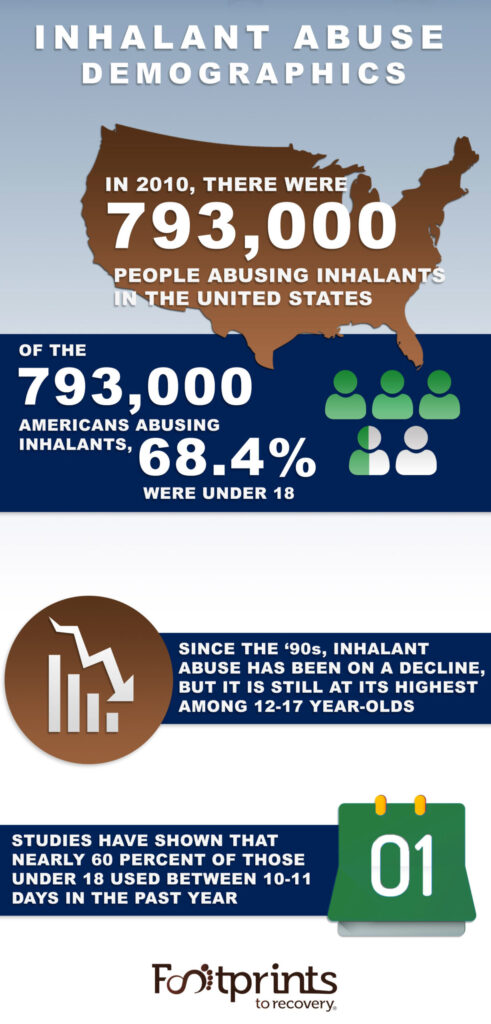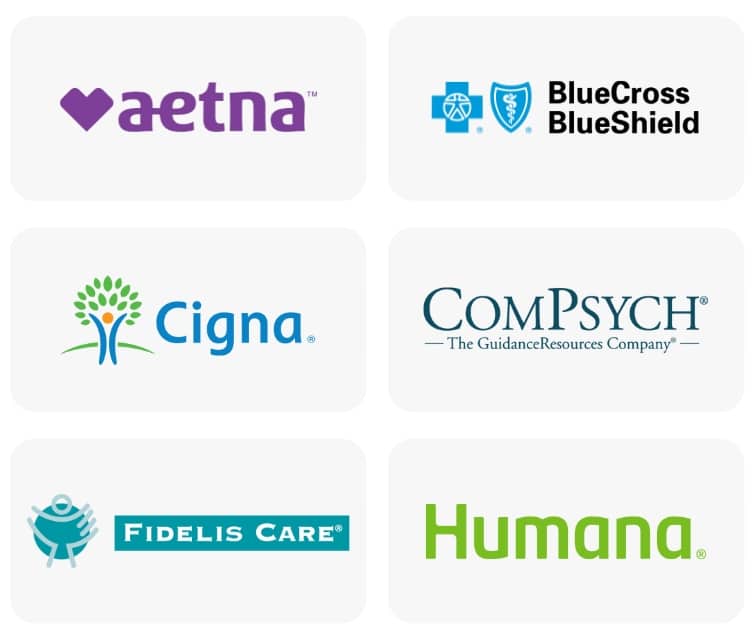Skip To Section
Inhalant abuse is also known as volatile substance abuse, solvent abuse, sniffing, huffing, and bagging. It is the intentional inhalation of a volatile substance to bring about an altered mental state. Inhalants are chosen for their low price, legal and easy availability, and ability to produce euphoria rapidly.
Inhalant abuse is a worldwide problem. It frequently affects younger children, compared to other forms of substance abuse. Teenagers and preteens are more likely to engage in this form of substance abuse than adults, especially since they can easily find these substances in their homes. It’s tougher for young people to get their hands on other recreational drugs, like alcohol, marijuana, and prescription drugs. Learn more about this type of abuse so you can find treatment for inhalants.

What Are Inhalants?
The term inhalants includes several volatile substances that may be abused to get high. The chemicals in inhalants can quickly lead to oxygen deprivation, seizures, heart failure, and other problems. Rather than getting high from it, users might die.
The most commonly abused inhalants, as reported to U.S. poison centers, are:
- Gasoline
- Paint
- Propane/butane
- Air fresheners
- Formalin (a mixture of formaldehyde and water used as an antiseptic or disinfectant)
Types of Inhalant Chemicals
Inhalants are volatile substances that produce chemical vapors, which when inhaled can cause intoxication and other negative effects on the body. Four main groups of inhalants are abused.
- Volatile solvents: These are chemicals that vaporize at room temperature. They’re usually found in inexpensive household products or industrial chemicals. Examples include degreasers, glue, paint thinner, paint remover, fluids used in dry cleaning, gasoline, correction fluid for white paper, and felt-tip markers, especially those labeled “permanent.”
- Aerosols: This group includes propellants and solvents that are pressurized in spray cans with a nozzle push to release them in a vapor. This includes spray paint, deodorant, hairspray, vegetable oils, fabric protector and freshener sprays, and air fresheners.
- Gases: There are two kinds of gases: household or commercial products and medical anesthetics. Nitrous oxide, or “laughing gas,” is most often administered in dental clinics, where dentists or nurses may also abuse the substance. Other medical anesthetics include chloroform and halothane. Nitrous oxide may also be abused in the form of “whippets,” or taking a hit from a whipped cream canister. Household and commercial gases include butane for lighters, propane for gas tanks, and refrigerants.
- Nitrites: While most inhalants are household or industrial chemicals, nitrites are a different category. They are more widely abused by young adults, especially gay men, while other inhalants are more often abused by adolescents. Rather than acting on the central nervous system for only a few minutes, nitrates dilate blood vessels and relax muscles.
For the most part, all these chemicals impact the brain and body for 15 to 45 seconds. The effects of nitrites and nitrous oxide may last longer, but they are still harmful chemicals.
Some people may think the “head rush” is worth it, even though they are at risk of sudden death or long-term physical damage. Many users simply aren’t aware of the risks.
What Are Poppers?
When abused for recreational reasons, nitrites are called “poppers” or “snappers” because of how the small bottles are opened. Chemicals sold for recreational use in this group include cyclohexyl nitrite, isoamyl (amyl) nitrite, and isobutyl (butyl) nitrite. They are widely abused in the party scene. The chemical eases pain and relaxes smooth muscles, making some types of sexual activity easier.
Nitrites are prohibited by the Consumer Product Safety Commission (CPSC), but they may still be sold legally when they are labeled “not for human consumption.” Some types of inhalants, like nitrous oxide, are found in dental clinics. Dentists, dental hygienists, and dental assistants are more likely to abuse these inhalants than others.
How Inhalants Are Used
The most common method of abusing inhalants is to breathe the chemical in, which is how this group of substances received its name.
Methods of abusing volatile chemicals include:
- Sniffing or snorting fumes by opening the container
- Spraying the chemical directly into the nose or mouth
- Spraying or dripping the chemical into a paper or plastic bag and then inhaling the fumes
- Putting the chemical on a rag, and then placing the rag over the nose or mouth and inhaling
- Taking balloons filled with nitrous oxide and breathing the chemical in
The high from inhalants lasts only a few minutes, but damage can occur quickly and last for a lifetime.
Anyone who abuses inhalants is at risk of harming their brains and bodies. Most people who abuse these substances are teenagers, who are still growing. This means they are at risk of suffering brain damage and bodily harm that could change their growth.
Signs of Inhalant Abuse
If your child or teenager is abusing inhalants, there are a few signs that can indicate their dangerous habit:
- Hidden rags, cloths, or bags with a chemical smell
- Containers of household products that seem to empty much faster than expected
- Stains or paint smears on clothing
- Constantly smelling their sleeves or other parts of their clothes
- Keeping a marker nearby or near their face
- Chemical odors coming from their breath or clothes
- Slurred or incoherent speech
- Changes in behavior, like eating or sleeping habits
- Appearing drunk or dazed
- Nausea and loss of appetite
- Rashes around the nose or mouth
- Loss of coordination and lack of attentiveness
- Depression or anxiety
Who Is Most Likely To Abuse Inhalants?
According to the 2010 National Survey on Drug Use and Health (NSDUH):
- About 793,000 people in the United States, ages 12 and older, abused inhalants. Of these, 68.4 percent were under the age of 18. These volatile chemicals are some of the easiest substances for adolescents to find and abuse.
- While inhalant abuse has declined since the 1990s, the prevalence is still highest among adolescents who are 12 to 17 years old — one of the most important periods of brain growth in a young person’s life.
- A 2015 report found that 684,000 adolescents between the ages of 12 and 17 had abused inhalants.
- Girls were more likely than boys to abuse these substances. Felt-tip pens or magic markers were the most common sources of inhalants.
- About 59 percent of the group reported that they abused inhalants anywhere from 1 to 11 days in the past year. While most kids’ inhalant abuse is infrequent, it is still very dangerous.
Other factors may impact whether a teenager or preteen begins abusing any substance. These factors are called “social determinants of health” and are especially common in groups that are not part of the mainstream. These groups are more likely to engage in substance abuse:
- Those in adverse socioeconomic situations
- People who have a history of child abuse
- Teens with poor grades, high truancy rates, or who have dropped out of school

Risks of Inhalant Abuse
Inhalant abuse can cause immediate and lasting damage, even after just one use. It’s known that volatile household or industrial chemicals are dangerous. Breathing in these chemicals is the same as breathing in other kinds of poison — they are toxic.
While cleaning or working in factories, people who use many of these products wear protective gear, including masks and gloves, because these substances can be so harmful.
Abusing chemical inhalants may lead to a short-term effect like an intense opioid high or being very drunk. Both short- and long-term inhalant abuse can cause brain damage from several sources, which can be particularly hard on an adolescent brain.)
Side Effects of Inhalant Abuse
Inhalants cause significant damage to the body, resulting in the following:
- Damage to the acoustic nerves and muscles, leading to hearing loss
- Oxygen deprivation, caused by blood cells being unable to carry oxygen
- Damage to bone marrow, leading to leukemia
- Damage to the cerebral cortex and cerebellum, which causes personality changes, hallucinations, memory impairment, loss of coordination, and slurred speech
- Heart failure called sudden sniffing death syndrome (SSDS)
- Kidney failure, as the kidneys can no longer pull acid out of the blood
- Kidney stones
- Accumulation of fatty tissue on the liver, leading to cirrhosis
- Impaired breathing from inhaling toxic chemicals
- Muscle deterioration
- Damage to the peripheral nerves, leading to numbness, pain, tingling, or paralysis in the extremities
- Rash around the nose and mouth, which can become infected
Inhalants cause significant damage to the brain, resulting in the following:
- Problems with memory
- Personality changes
- Learning disabilities
- Speaking problems
- Hallucinations
- Problems with complex problem-solving, organization, and planning
- Vision problems
- Movement problems (difficulties with walking, muscle spasms, tremors)
Both short-term and long-term inhalant abuse have been known to cause brain damage from several sources, which can be particularly hard on an adolescent brain. There’s also a risk of sudden death with repeated use.
Some household products, especially solvents and aerosol sprays, contain high concentrations of harmful chemicals. Sniffing these can lead to seizures, coma, and sudden cardiac arrest (heart stops). This can even happen to first-time users. Placing a plastic bag over your head to breathe in the inhalant can cause suffocation. Replacing oxygen in the lungs with toxic fumes can cause death by asphyxiation.
Emergency treatment for inhalant overdose means treating the life-threatening event that occurs as a result. It may be necessary to stop the seizure or restart the heart. There are no treatments to reverse the effects of inhalant intoxication.
Can Inhalant Abuse Be Prevented?
Research has shown that teaching adolescents life skills training in school has helped reduce inhalant use. Training should concentrate on improving self-esteem and communication, repairing relationships, and managing anxiety and pressure.
Parents also need to be educated about the risks and warning signs of inhalant abuse. The dangers of death, burns, flash fires, and serious brain damage should be restated to patients who are at risk. Promoting the education of parents, teachers, and children is fundamental in reducing inhalant use.
Can You Get Addicted to Inhalants?
It’s possible to develop an addiction to inhalants. They can be both psychologically and physically addictive, like any other drug. Users describe a strong craving to continue using inhalants, especially after sustained usage over many days. Tolerance can develop with frequent use, and withdrawal syndrome can occur when the person stops.
"*" indicates required fields
Fill out the form below and one of our admissions team members will reach out to you:
"*" indicates required fields
Diagnosing Inhalant Addiction
Inhalants are not detected by conventional urine drug screening tests. Detection depends on a clinical diagnosis by knowledgeable medical professionals. Testing can show abnormal lab results such as elevated liver enzymes.
Tests can be done on blood and other tissues using gas chromatography, which screens the presence of substances found in inhaled solvents. Specific urine tests can trace benzene, toluene, and similar substances if they have been abused for a long time.
Friends and parents of inhalant abusers need to be aware of the visible signs of misuse.
Treatment for Inhalant Addiction
Methods for treating an inhalant addiction are not very different from the methods used to treat any other addictive behavior.
Inhalant Detox
When withdrawing from inhalants, the individual will need support in a controlled setting, with medical supervision In detox, clients withdrawing from inhalants receive 24/7 monitoring for heart and neurological issues.
Inhalant withdrawal symptoms are similar to the withdrawal symptoms from benzodiazepine or alcohol addiction. Withdrawal can last a month or longer, and the chance of relapse is high.
Sustained inhalant abuse, especially of nitrites or nitrous oxide, can cause withdrawal symptoms when the person attempts to stop. These may include the following:
- Sweating
- Rapid pulse
- Cravings
- Hand tremors
- Insomnia
- Physical agitation
- Vomiting
- Hallucinations
- Anxiety
- Seizures
Residential Treatment
Residential treatment for inhalants is the highest level of care. The patient lives at the treatment center and has 24-hour medical care and supervision. This is important as it removes the patient from the distractions and triggers in the outside world. This is time to concentrate on himself and his disease.
Outpatient Treatment
Outpatient treatment for inhalants offers a structured, supportive environment for individuals struggling with addiction to inhalant substances. Outpatient programs include:
- Partial Hospitalization Program (PHP): This program is an intensive treatment option even though the patient does not live at the treatment center. The individual receives the same therapies and medical assistance, but can go home at night.
- Intensive Outpatient Program (IOP): The IOP could be considered the step-down program from PHP or Residential. Patients attend counseling and therapy sessions several days a week for several hours. They live at home and apply the skills learned in therapy to real life.
- Outpatient Program (OP): This is a lower level of care and may be used as a step-down. The patient will still attend sessions but with less frequency.
Find Quality Treatment for Inhalants at Footprints
Now, all you have to do is check out Footprints to Recovery. You will get a full medical assessment and the treatment you need. We have a knowledgeable and caring staff who recognize that every patient is unique and deserves respect. You already know the alternative to getting treatment. Footprints to Recovery can help you or your loved one look to the future. Contact us today for more information.
- Inhalants | National Institute on Drug Abuse (NIDA)
- Mind Matters: The Body’s Response to Inhalants | National Institute on Drug Abuse (NIDA)
- Commonly Used Drugs Charts
- Parents: Know about Inhalant Abuse | Poison Control
- Teen drug abuse: Help your teen avoid drugs – Mayo Clinic
- A Parent’s Guide to Preventing Inhalant Abuse | CPSC.gov
- Inhalant Use and Inhalant Use Disorders in the United States – PMC
- Understanding Adolescent Inhalant Use
- The Clinical Assessment and Treatment of Inhalant Abuse | The Permanente Journal
Our admissions team is available 24/7 to listen to your story and help you get started with the next steps.








